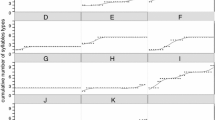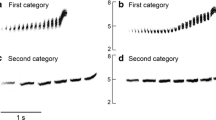Abstract
To attract a breeding partner, males may behave differently when they are bachelors compared to when they are paired. Comparisons between groups of paired males versus groups of unpaired males in temperate-breeding animals have revealed such differences in signalling behaviour. Few studies, however, have explored how individual males alter their signalling behaviour with changes in pairing status, and very few investigations have explored paired versus unpaired male behaviour in tropical animals. During a 5-year study in Costa Rica, we analysed changes in the singing behaviour of male rufous-and-white wrens (Thryothorus rufalbus) when they were paired and when they were bachelors. We compared three aspects of male vocal behaviour: gross differences in song output, variation in repertoire use and differences in song structure. Males as bachelors had significantly higher song output and switched song types less frequently. Contrary to our expectation, bachelors sang significantly fewer song types from their repertoire compared to when those same males had a breeding partner. Songs sung by bachelor males were higher in syllabic diversity and had broader-bandwidth terminal syllables than the songs those males sang only when paired. Within song types, the fine structure of songs remained consistent across pairing status. Our results demonstrate that males change their singing behaviour with pairing status, delivering songs at a higher rate but with less variety when they are bachelors. Rufous-and-white wrens are renowned for their vocal duets, and we discuss the pattern of repertoire use in light of their duetting behaviour. These results enhance our understanding of how male behaviour varies with pairing status and the importance of vocal signalling behaviour in socially monogamous tropical animals.



Similar content being viewed by others
References
Amrhein V, Kunc HP, Naguib M (2004) Seasonal patterns of singing activity vary with time of day in the nightingale (Luscinia megarhynchos). Auk 121:110–117
Ballentine B, Hyman J, Nowicki S (2004) Vocal performance influences female response to male bird song: an experimental test. Behav Ecol 151:163–168
Beecher MD, Brenowitz EA (2005) Functional aspects of song learning in songbirds. Trends Ecol Evol 20:143–149
Bosch J, Rand AS, Ryan MJ (2000) Signal variation and call preferences for whine frequency in the tungara frog, Physalaemus pustulosus. Behav Ecol Sociobiol 49:62–66
Catchpole CK, Slater PJB (2008) Bird song: biological themes and variations. Cambridge University Press, Cambridge
Cuthill I, Hindmarsh A (1985) Increase in starling song activity with removal of mate. Anim Behav 33:326–327
Cuthbert JL, Mennill DJ (2007) The duetting behaviour of Pacific coast plain wrens (Thryothorus modestus modestus). Condor 109:686–692
Eens M, Pinxten R, Verheyen RF (1993) Function of the song and song repertoire in the European starling (Sturnus vulgaris)—an aviary experiment. Behaviour 125:51–66
Evans JP, Bisazza A, Pilastro A (2004) Female mating preferences for colourful males in a population of guppies subject to high predation. J Fish Biol 65:1154–1159
Gil D, Gahr M (2002) The honesty of bird song: multiple constraints for multiple traits. Trends Ecol Evol 17:133–141
Hasselquist D, Bensch S, vonSchantz T (1996) Correlation between male song repertoire, extra-pair paternity and offspring survival in the great reed warbler. Nature 381:229–232
Hayes JP, Probst JR, Rakstad D (1986) Effect of mating status and time of day on Kirtland warbler song rates. Condor 88:386–388
Hill GE, Mennill DJ, Rolek BW, Hicks TL, Swiston KA (2006) Evidence suggesting that ivory-billed woodpeckers (Campephilus principalis) exist in Florida. Avian Cons Ecol Écol Cons Oiseaux 1:2 http://www.ace-eco.org/vol1/iss3/art2/
Klump GM, Shalter MD (1984) Acoustic behaviour of birds and mammals in the predator context. I. Factors affecting the structure of alarm signals. II. The functional significance and evolution of alarm signals. Z Tierpsychol 66:189–226
Krebs JR, Avery M, Cowie RJ (1981) Effect of removal of mate on the singing behavior of great tits. Anim Behav 29:635–637
Kroodsma DE (1999) Aspects of learning in the ontogeny of bird song: where, from whom, when, how many, which, and how accurately? In: Bolhuis JJ, Hogan JA (eds) The development of animal behaviour: a reader. Blackwell, Oxford, pp 209–218
Kunc HP, Amrhein V, Naguib M (2007) Vocal interactions in common nightingales (Luscinia megarhynchos): males take it easy after pairing. Behav Ecol Sociobiol 61:557–563
Lambrechts MM (1997) Song frequency plasticity and composition of phrase versions in great tits Parus major. Ardea 85:99–109
Levin RN (1996) Song behaviour and reproductive strategies in a duetting wren, Thryothorus nigricapillus.1. Removal experiments. Anim Behav 52:1093–1106
Logue DM (2006) The duet code of the female black-bellied wren. Condor 108:326–335
Mann NI, Marshall-Ball L, Slater PJB (2003) The complex song duet of the plain wren. Condor 105:672–682
Mennill DJ, Vehrencamp SL (2005) Sex differences in singing and duetting behavior of neotropical rufous-and-white wrens (Thryothorus rufalbus). Auk 122:175–186
Mennill DJ, Vehrencamp SL (2008) Context-dependent functions of avian duets revealed through microphone array recordings and multi-speaker playback. Curr Biol 18:314–1319
Molles LE (2006) Singing complexity of the banded wren (Thryothorus pleurostictus): do switching rate and song-type diversity send different messages? Auk 123:991–1003
Mountjoy DJ, Lemon RE (1996) Female choice for complex song in the European starling: a field experiment. Behav Ecol Sociobiol 38:65–71
Otter K, Ratcliffe L (1993) Changes in singing behavior of male black-capped chickadees (Parus atricapillus) following mate removal. Behav Ecol and Sociobiol 33:409–414
Otter K, Chruszcz B, Ratcliffe L (1997) Honest advertisement and song output during the dawn chorus of black-capped chickadees. Behav Ecol 8:167–173
Podos J (1997) A performance constraint on the evolution of trilled vocalizations in a songbird family (Passeriformes: Emberizidae). Evolution 51:537–551
Podos J, Nowicki S (2005) Performance limits on birdsong. In: Marler P, Slabbekoorn H (eds) Nature’s music: the science of bird song. Elsevier, London, pp 318–342
Reid JM, Arcese P, Cassidy ALEV, Hiebert SM, Smith JNM, Stoddard PK, Marr AB, Keller LS (2004) Song repertoire size predicts initial mating success in male song sparrows, Melospiza melodia. Anim Behav 68:1055–1063
Roth T, Sprau P, Schmidt R, Naguib M, Amrhein V (2009) Sex-specific timing of mate searching and territory prospecting in the nightingale: nocturnal life of females. Proc R Soc B 276:2045–2050
Searcy WA (1984) Song repertoire and female preferences in song sparrows. Behav Ecol Sociobiol 14:281–286
Searcy WA, Yasukawa K (1996) Song and female choice. In: Kroodsma DE, Miller EH (eds) Ecology and evolution of acoustic communication in birds. Cornell University Press, Ithaca, pp 454–473
Staicer CA (1996) Honest advertisement of pairing status: evidence from a tropical resident wood-warbler. Anim Behav 51:375–390
Staicer CA, Ingalls V, Sherry TW (2006) Singing behavior varies with breeding status of American redstarts (Setophaga ruticilla). Wilson J Ornithol 118:439–451
Topp SM, Mennill DJ (2008) Seasonal variation in the duetting behaviour of rufous-and-white wrens (Thryothorus rufalbus). Behav Ecol Sociobiol 62:1107–1117
Valderrama S, Parra J, Davlia N, Mennill DJ (2008) The vocal behavior of the critically-endangered Niceforo’s wren (Thryothorus nicefori). Auk 125:395–401
Vehrencamp SL (2000) Handicap, index, and conventional signal elements of bird song. In: Espmark Y, Amundsen T, Rosenqvist G (eds) Animal signals: Signalling and signal design in animal communication. Tapir Academic Press, Trondheim, pp 277–300
Yasukawa K, Blank JL, Patterson CB (1980) Song repertories and sexual selection in the red-winged blackbird. Behav Ecol Sociobiol 7:233–238
Zahavi A (1975) Mate selection—selection for a handicap. J Theor Biol 53:205–214
Acknowledgements
We thank the staff of the Area de Conservación Guanacaste for logistical support, particularly R. Blanco and M. M. Chavarria. We thank other field researchers who collected rufous-and-white wren recordings that contributed, in part, to this study: C. Calaustro, V. Connolly, D. Moseley, J. Mouland and S. Topp. For funding, we thank the University of Windsor, the Natural Sciences and Engineering Research Council of Canada (NSERC), the National Geographic Society, Canada’s Foundation for Innovation (CFI), the Ontario government, the Society for Canadian Ornithologists and the Association of Universities and Colleges of Canada for grants to D.J.M.
Ethical standards
The authors’ methods for this study complied with current rules and regulations within Canada and Costa Rica.
Conflicts of interest
The authors declare that they have no conflict of interest.
Author information
Authors and Affiliations
Corresponding author
Additional information
Communicated by W. Searcy
Rights and permissions
About this article
Cite this article
Hennin, H.L., Barker, N.K.S., Bradley, D.W. et al. Bachelor and paired male rufous-and-white wrens use different singing strategies. Behav Ecol Sociobiol 64, 151–159 (2009). https://doi.org/10.1007/s00265-009-0832-4
Received:
Accepted:
Published:
Issue Date:
DOI: https://doi.org/10.1007/s00265-009-0832-4




